Related Research Articles

Hockey is a term used to denote a family of various types of both summer and winter team sports which originated on either an outdoor field, sheet of ice, or dry floor such as in a gymnasium. While these sports vary in specific rules, numbers of players, apparel, and playing surface, they share broad characteristics of two opposing teams using a stick to propel a ball or disk into a goal.

Ice hockey is a team sport played on ice skates, usually on an ice skating rink with lines and markings specific to the sport. It belongs to a family of sports called hockey. In ice hockey, two opposing teams use ice hockey sticks to control, advance, and shoot a closed, vulcanized, rubber disc called a "puck" into the other team's goal. Each goal is worth one point. The team which scores the most goals is declared the winner. In a formal game, each team has six skaters on the ice at a time, barring any penalties, one of whom is the goaltender. Ice hockey is a full contact sport, and is considered to be one of the more physically demanding team sports.
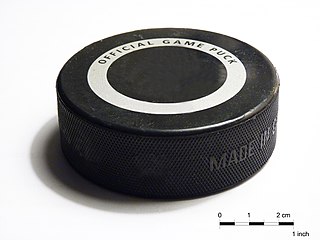
A hockey puck is either an open or closed disk used in a variety of sports and games. There are designs made for use on an ice surface, such as in ice hockey, and others for the different variants of floor hockey which includes the wheeled skate variant of inline hockey. They are all designed to serve the same function a ball does in ball games.

In many team sports that involve scoring goals, the goalkeeper is a designated player charged with directly preventing the opposing team from scoring by blocking or intercepting opposing shots on goal. Such positions exist in bandy, rink bandy, camogie, association football, Gaelic football, international rules football, floorball, handball, hurling, field hockey, ice hockey, roller hockey, lacrosse, ringette, rinkball, water polo, and shinty, as well as in other sports.

In many team sports, defense or defence is the action of preventing an opponent from scoring. The term may also refer to the tactics involved in defense, or a sub-team whose primary responsibility is defense. Similarly, a defense player or defender is a player who is generally charged with preventing the other team's forwards from being able to bear down directly on their own team's goalkeeper or goaltender. Such positions exist in association football, ice hockey, water polo and many other sports.

An ice hockey rink is an ice rink that is specifically designed for ice hockey, a competitive team sport. Alternatively it is used for other sports such as broomball, ringette, rinkball, and rink bandy. It is a rectangle with rounded corners and surrounded by walls approximately 1.22 metres (48 in) high called the boards.

A goaltender mask, commonly referred to as a goalie mask, is a mask worn by goaltenders in a variety of sports to protect the head and face from injury from the ball or puck, as they constantly face incoming shots on goal. Some sports requiring their use include ice hockey, lacrosse, inline hockey, field hockey, rink hockey, ringette, bandy, rinkball, broomball, and floorball. This article deals chiefly with the goal masks used in ice hockey.
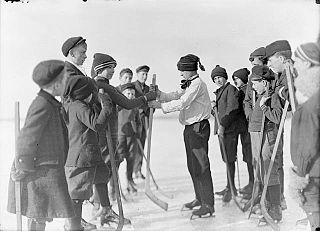
Shinny is an informal type of hockey played on ice. It is also used as another term for street hockey. There are no formal rules or specific positions, and often, there are no goaltenders. The goal areas at each end may be marked by nets, or simply by objects, such as stones or blocks of snow. Body checking and lifting or "roofing/reefing/raising the puck" are often forbidden because the players are not wearing protective equipment. Shinny is a game that all levels of hockey enthusiasts can play because it requires no rink, requires no skills except ability to hold a stick and at the very least to try to touch the puck or ball when it goes by. Shinny may be completely non-competitive and recreational.
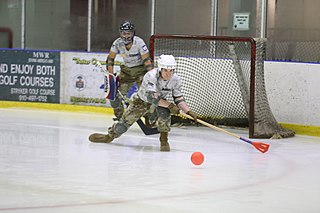
Broomball is a both a recreational and organized competitive winter team sport played on ice or snow and is played either indoors or outdoors, depending on climate and location. It is a ball sport and is most popularly played in Canada and the United States.
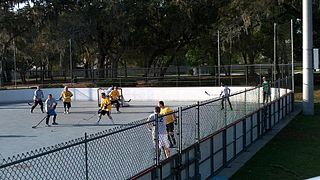
Street hockey is a collection of team sport variants played outdoors either on foot or with wheeled skates, using a either a ball or puck designed for play on flat, dry surfaces. The object of every game is to score more goals than the opposing team by shooting the ball or puck into the opposing team's net. All games are derivatives of either the sport of ice hockey, floor hockey, bandy, and/or field hockey.

Floor hockey is a broad term for several indoor floor game codes which involve two teams using a stick and type of ball or disk. Disks are either open or closed but both designs are usually referred to as "pucks". These games are played either on foot or with wheeled skates. Variants typically reflect the style of ice hockey, field hockey, bandy or some other combination of sport. Games are commonly known by various names including cosom hockey, ball hockey, floorball, or simply floor hockey.
Power Hockey also known as Powerchair Hockey is a competitive, fast-paced hockey game based on the use of a power wheelchair. The foundation of the sport derives from ice hockey and floor hockey, but with adapted rules to enable people with disabilities, who use a power wheelchair, to play and be active in a competitive team setting. The sport is also referred to as Electric Wheelchair Hockey or Electric Wheelchair Floorball in various parts of the world.
This is a list of common terms used in the sport of ice hockey along with the definitions of these terms.
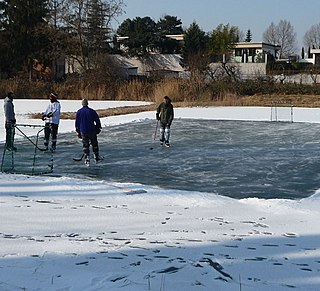
Pond hockey is a form of ice hockey similar in its object and appearance to traditional ice hockey, but simplified and designed to be played on part of a natural frozen body of water. The rink is 50 to 80 percent the size of a standard NHL-specification rink, and has no boards or glass surrounding it; usually only a barrier of snow keeps the puck in play. In addition, because there are no protective barriers behind the goal to contain high errant shots, the top of the goal is lower, in fact only slightly taller than the width of a puck, and the game does not have a formal goalie. Because of these differences, pond hockey places more emphasis on skating and puckhandling ability and less on shooting and checking. Non-competitive pond hockey is played with improvised goals, rinks of a variety of sizes, and no boards or snow barriers. There can only be 4 players playing per team at a time but have many subs to sub in.
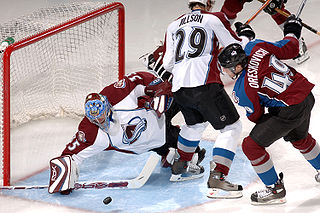
In ice hockey, a goaltender is credited with a save when they prevent a shot by the opponent from entering the net. A goaltender's efficiency in stopping shots, the save percentage, is calculated as a percentage of shots stopped divided by the total number of shots on goal. If a goaltender makes all the saves within a game it is called a shutout. In association football this is called a clean sheet.

An empty net goal, abbreviated as EN or ENG and colloquially called an empty netter, occurs in several team sports when a team scores a goal into a net with no goaltender (goalie) present.

Offside is a rule used by several different team sports regulating aspects of player positioning. It is particularly used in field sports with rules deriving from the various codes of football, such as association football, rugby union and rugby league, and in similar 'stick and ball' sports e.g. ice hockey, broomball, field hockey and bandy.

Pads are a type of protective equipment used in a number of sports and serve to protect the legs from the impact of a hard ball, puck, or other object of play travelling at high speed which could otherwise cause injuries to the lower legs. These are used by batters in the sport of cricket, catchers in the sports of baseball and fastpitch softball, and by goaltenders in sports such as ice hockey, ringette, bandy, rinkball, field hockey, rink hockey and box lacrosse.
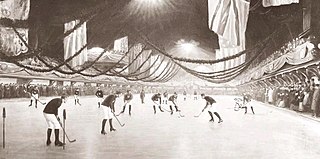
On March 3, 1875, the first recorded indoor ice hockey game took place at the Victoria Skating Rink in Montreal, Quebec. Organized by James Creighton, who captained one of the teams, the game was between two nine-member teams, using a rubber "puck". Members used skates and sticks used for outdoor hockey and shinny games in Nova Scotia, where Creighton was born and raised. It is recognized as the first organized ice hockey game.
References
- The Playground: The World at Play. Vol. 9. New York City: Playground Association of America. April 1915. LCCN 99104272. OCLC 1762485. OL 7168031M.
- Adair, Alex (26 June 2003). "Foot hockey?!?". Toronto Star .
- Blake, Jason (2010). Canadian hockey literature: a thematic study. University of Toronto Press. ISBN 978-0-8020-9713-2.
- Byl, John (2002). Intramural recreation: a step-by-step guide to creating an effective program. Human Kinetics. ISBN 978-0-7360-3454-8.
- Coffey, Wayne R. (2005). The boys of winter: the untold story of a coach, a dream, and the 1980 U.S. Olympic hockey team. Random House Digital, Inc. ISBN 978-1-4000-4765-9.
- Harris, Cecil (2005). Breaking the Ice: The Black Experience in Professional Hockey . Insomniac Press. ISBN 978-1-894663-80-9.
- McFarlane, Brian (1984). Brian Mcfarlane's NHL Hockey 1984. McClelland and Stewart. ISBN 978-0-7710-5431-0.
- Manning, Sally (2002). A golden tear: Danièle Sauvageau's journey to Olympic gold. General Store Publishing House. ISBN 978-1-894263-69-6.
- Pawlenty, Tim (2011). Courage to Stand: An American Story. Tyndale House Publishers, Inc. ISBN 978-1-4143-4572-7.
- Roth, Leo F. (1994). Jim Kelly, star quarterback. Enslow. ISBN 978-0-89490-446-2.
- Tator, Charles H. (2008). Catastrophic injuries in sports and recreation: causes and prevention : a Canadian study. University of Toronto Press. p. 761. ISBN 978-0-8020-8967-0.
- Thorkelson, Berit (2006). You Know You're in Minnesota When...: 101 Quintessential Places, People, Events, Customs, Lingo, and Eats of the North Star ThorkelsonState . Globe Pequot. ISBN 978-0-7627-3895-3.
- "Boot Hockey rules". Timberland Boot Hockey. U.S. Pond Hockey Championships. Retrieved 2012-03-16.
Notes
- ↑ Adair: 2003, page P13. Foot hockey is sort of a combination of hockey, soccer and handball. Its end-to-end action just like in hockey.
- ↑ Harris: 2005, pg 97. ...more like a form of soccer with a tennis ball, on streets and in parks.
- ↑ Pawlenty: , page 20. A few different rules applied, but the full-contact nature of the sport was fully intact. Even without pads. Even when your sisters were playing. It was a tough game, and you got to know it fast because everyone got in on the action.
- ↑ Tator: 2008, page 363. Sports such as snowboarding and ice hockey produced a large number of injuries, whereas other winter sports, such as ringette, broomball, boot hockey, and curling, produced fewer injuries.
- ↑ Bryan, Tanis H.; Wong, Bernice Y. L.; Donahue, Mavis (2002). The social dimensions of learning disabilities: essays in honor of Tanis Bryan. Psychology Press. p. 196. ISBN 0-8058-3918-6.
- ↑ Kerz, Anna (2009). The Mealworm Diaries. Orca. p. 19. ISBN 978-1-55143-982-2.
- ↑ Walters, Eric (1999). Three on Three. Orca. p. 19. ISBN 1-55143-170-X.
- ↑ Walters, Eric (2001). Full Court Press. Orca. p. 5. ISBN 1-55143-169-6.
- ↑ Squizzato, Daniel. "Reserve Squad Classic: Canadian officials rebrand soccer as "foot hockey"". Canadian Soccer News. Archived from the original on January 31, 2013. Retrieved March 19, 2012.
- ↑ Blake: 2010, page 56. The Canadian identification with shinny is more comprehensive than with organized hockey because games like 'street hockey' or 'boot hockey' are open to all and do not cut off those who cannot afford team registration.
- ↑ Playground Association of America: 1915, pages 340—341. Other games to be played are: Volleyball, caddy, day and night, dodge ball, hang baseball, captain ball, long baseball, goal throwing, baseball, throw for distance, basketball, battle ball, scrimmage, duck on rock, circle wrestling, tender green, three deep, marbles (ring), prisoners' base, hustle ball, foot and a half, mounted combat, foot hockey, fly ball catching. Athletic events can also be conducted by following the group or team idea.
- ↑ McFarlane: 1984. Often the boys would play "foot hockey" in the arena stairwell, using crushed paper cups as pucks.
- ↑ Harris: 2005, page 193. Carter, the New York Rangers forward, grew up in the Toronto suburb of Scarborough where "foot hockey" was his introduction to the sport.
- ↑ Coffey: 2005, page 146. Hockey was a way of life for Neal Broten almost from the start. Games would break out on the kitchen floor, three brothers battling around a rolled-up pair of socks. Out front on the street they'd play boot hockey...
- ↑ https://montrealgazette.com/news/Harper+invent+foot+hockey/5641044/story.html [ dead link ]
- ↑ Sanajaoba, Naorem (2003). Manipur, past and present. Mittal. p. 198. ISBN 81-7099-853-0.
- ↑ Coffey: 2005, page 146. Out front on the street they'd play boot hockey, using two snow chunks for goalposts and walls of plowed snow as sideboards, the same as kids would on the Range and all over northern Minnesota.
- ↑ Adair: 2003, page P13. You have to kick the tennis ball past the goaltender, who has a jacket or a hat to try to stop the ball.
- ↑ Thorkelson: 2006. This is also the time when street hockey morphs into boot hockey—street hockey in boots. Play still happens in alleys and driveways, but frozen ponds, lakes, and rinks are better options.
- ↑ Blake: 2010, page 56. Everyone who ever played hockey has memories of shinny called pond hockey, street hockey, or boot hockey, depending on what part of the country you grew up in.
- ↑ Byl:2002 , page 88.
- ↑ Byl: 2002, pages 86—87. Nontraditional events are also a great opportunity equalizer. Some schools have had success with activities such as boot hockey (floor hockey without the sticks, and using a tennis ball that is advanced toward the goal by players kicking it), ...
- ↑ "Hockey History and Rules". Scommesse Sportive Mania. Archived from the original on 2012-06-10. Retrieved March 19, 2012.
- ↑ Blake: 2010, page 57. In fact, anything that is handy can substitute for a puck. Tennis balls are highly recommended, but everything from lumps of coal to small rocks to temperature-sensitive 'road apples' will do.
- ↑ Byl:2002 , page 87.
- ↑ U.S. Pond Hockey Championships, rule 1
- ↑ U.S. Pond Hockey Championships, rule 7
- ↑ Tator: 2008, page 366. Always wear a helmet, faceguard, and the appropriate padding and footwear in ringette, broom ball, and boot hockey.
- ↑ Tator: 2008, page 365. When these risks are avoided, broomball, curling, boot hockey, and ringette are considered to be safe, low-risk activities.
- ↑ Manning: 2002. After Newfoundland, the players were given a week-long hiatus from hockey to return home for the Christmas break. Danièle and Ryan Jankowski, the video expert, had put together a Christmas package for each to open under the tree. It was a video entitled Just Smile. The footage documented good times the team had shared together over the 2001 season: the obstacle course at Val Cartier; an aerobic session in the gym; a Finnish sauna experience; a game of foot hockey, a favourite warm-up; gift-giving at the end-of-the-year Christmas party.
- ↑ Roth:1994, page 19. In the winter boys played foot hockey on the frozen river. In the summer they would dive into the Allegheny River off a giant steel bridge near town.
- ↑ Pawlenty: , page 20. For years my dad set up a little ice rink in the backyard so the neighbourhood kids could come over for games of hockey. sometimes the game was boot hockey, sort of like ice hockey but without the skates, usually played with a tennis ball instead of a puck.